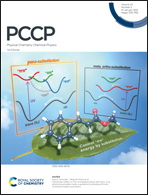The physical significance of the Kamlet–Taft π* parameter of ionic liquids†
Abstract
The Kamlet–Taft dipolarity/polarizability parameters π* for various ionic liquids were determined using 4-tert-butyl-2-((dicyanomethylene)-5-[4-N,N-diethylamino)-benzylidene]-Δ3-thiazoline and 5-(N,N-dimethylamino)-5′-nitro-2,2′-bithiophene as solvatochromic probes. In contrast to the established π*-probe N,N-diethylnitroaniline, the chromophores presented here show excellent agreement with polarity measurement using the chemical shift of 129Xe. They do not suffer from additional bathochromic UV/vis shifts caused by hydrogen-bonding resulting in too high π*-values for some ionic liquids. In combination with large sets of various ionic liquids, these new chromophores thereby allow for detailed analysis of the physical significance of π* and the comparison to quantum-mechanical methods. We find that π* correlates strongly with the ratio of molar refractivity to molar volume, and thus with the refractive index.



 Please wait while we load your content...
Please wait while we load your content...